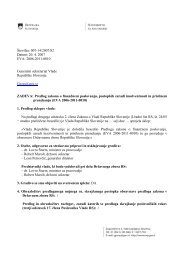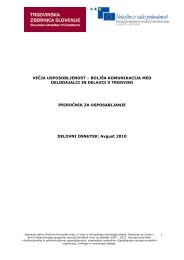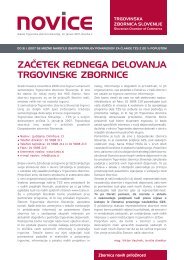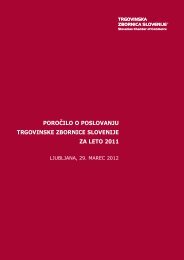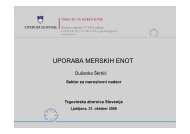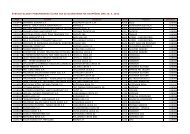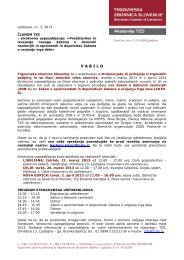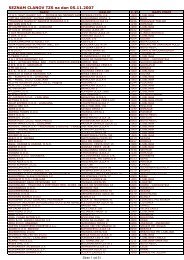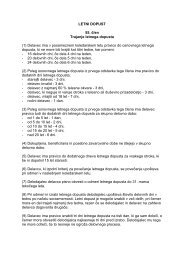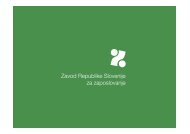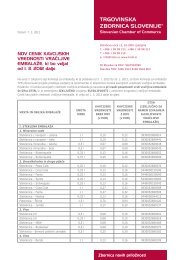Draft Commission Regulation on ceramic materials and
Draft Commission Regulation on ceramic materials and
Draft Commission Regulation on ceramic materials and
Create successful ePaper yourself
Turn your PDF publications into a flip-book with our unique Google optimized e-Paper software.
EUROPEAN COMMISSION<br />
Brussels, XXX<br />
[…](2012) XXX draft<br />
DRAFT - DRAFT<br />
COMMISSION REGULATION (EU) No …/..<br />
of XXX<br />
<strong>on</strong> <strong>ceramic</strong> <strong>materials</strong> <strong>and</strong> articles intended to come into c<strong>on</strong>tact with food<br />
DRAFT - DRAFT<br />
(Text with EEA relevance)<br />
EN<br />
EN
COMMISSION REGULATION (EU) No …/..<br />
of XXX<br />
<strong>on</strong> <strong>ceramic</strong> <strong>materials</strong> <strong>and</strong> articles intended to come into c<strong>on</strong>tact with food<br />
FIRST DRAFT - FIRST DRAFT<br />
(Text with EEA relevance)<br />
THE EUROPEAN COMMISSION,<br />
Having regard to the Treaty <strong>on</strong> the Functi<strong>on</strong>ing of the European Uni<strong>on</strong>,<br />
Having regard to <str<strong>on</strong>g>Regulati<strong>on</strong></str<strong>on</strong>g> (EC) No 1935/2004 of the European Parliament <strong>and</strong> of the<br />
Council of 27 October 2004 <strong>on</strong> <strong>materials</strong> <strong>and</strong> articles intended to come into c<strong>on</strong>tact with food<br />
<strong>and</strong> repealing Directives 80/590/EEC <strong>and</strong> 89/109/EEC 1 , <strong>and</strong> in particular Article 5(1) (e), (g),<br />
(h), (i), <strong>and</strong> (j) thereof,<br />
After c<strong>on</strong>sulting with the European Food Safety Authority,<br />
Whereas (not complete yet?):<br />
(1) <str<strong>on</strong>g>Regulati<strong>on</strong></str<strong>on</strong>g> (EC) No 1935/2004 lays down the general principles for eliminating the<br />
differences between the laws of the Member States as regards food c<strong>on</strong>tact <strong>materials</strong>.<br />
Article 5(1) of that <str<strong>on</strong>g>Regulati<strong>on</strong></str<strong>on</strong>g> provides for the adopti<strong>on</strong> of specific measures for<br />
groups of <strong>materials</strong> <strong>and</strong> articles.<br />
(2) This <str<strong>on</strong>g>Regulati<strong>on</strong></str<strong>on</strong>g> is a specific measure within the meaning of Article 5(1) of <str<strong>on</strong>g>Regulati<strong>on</strong></str<strong>on</strong>g><br />
(EC) No 1935/2004. This <str<strong>on</strong>g>Regulati<strong>on</strong></str<strong>on</strong>g> should establish the specific rules for <strong>ceramic</strong><br />
<strong>materials</strong> <strong>and</strong> articles to be applied for their safe use <strong>and</strong> supersedes Council Directive<br />
84/500/EEC of 15 October 1984 <strong>on</strong> the approximati<strong>on</strong> of the laws of the Member<br />
States relating to <strong>ceramic</strong> articles intended to come into c<strong>on</strong>tact with foodstuffs 2 , <strong>and</strong><br />
amended by <str<strong>on</strong>g>Commissi<strong>on</strong></str<strong>on</strong>g> Directive 2005/31/EC of 29 April 2005 3 .<br />
(3) Directive 84/500/EEC sets out limits for the transfer of lead <strong>and</strong> cadmium from<br />
<strong>ceramic</strong> articles which are intended to come into c<strong>on</strong>tact with food. New scientific<br />
1<br />
2<br />
3<br />
OJ L 338, 13.11.2004, p. 4.<br />
OJ L 287, 20.10.1984, p. 12.<br />
OJ L 110, 30.4.2005, p. 36<br />
EN DRAFT 2 DRAFT EN
evidence published by the European Food Safety Authority shows that these limits<br />
need to be reduced 4,5 .<br />
(4) In the future scientific evidence may become available for other metals, requiring the<br />
additi<strong>on</strong> of further limits. The Directive does not establish a means for changing or<br />
adding such limits. In additi<strong>on</strong> other aspects of the Directive require changes <strong>and</strong><br />
updates for reas<strong>on</strong>s of clarity <strong>and</strong> c<strong>on</strong>sistency with other legislati<strong>on</strong> in the food c<strong>on</strong>tact<br />
<strong>materials</strong> sector, including the provisi<strong>on</strong>s laying down the testing rules, declarati<strong>on</strong> of<br />
compliance <strong>and</strong> supporting documentati<strong>on</strong>, <strong>and</strong> the overall structure. Therefore a new<br />
measure under Article 5(1) of <str<strong>on</strong>g>Regulati<strong>on</strong></str<strong>on</strong>g> (EC) No 1935/2004 is c<strong>on</strong>sidered the most<br />
appropriate.<br />
(5) In the past Directive 84/500/EEC <strong>and</strong> its amendment have been transposed into<br />
nati<strong>on</strong>al legislati<strong>on</strong> without any major adaptati<strong>on</strong>. For transpositi<strong>on</strong> into nati<strong>on</strong>al law<br />
usually a time period of 12 m<strong>on</strong>ths is necessary. Because due to the nature of this<br />
legislati<strong>on</strong> there is little room for adaptati<strong>on</strong> during transpositi<strong>on</strong> without affecting the<br />
single market, it seems appropriate to adopt rules <strong>on</strong> <strong>ceramic</strong> <strong>materials</strong> <strong>and</strong> articles in<br />
form of a <str<strong>on</strong>g>Regulati<strong>on</strong></str<strong>on</strong>g> directly applicable in all Member States.<br />
(6) Final articles made of <strong>ceramic</strong> <strong>materials</strong> may be enamelled or glazed, <strong>and</strong> may be<br />
decorated. The <strong>ceramic</strong> material, the enamel or glazing, <strong>and</strong> the decorati<strong>on</strong> may all<br />
c<strong>on</strong>tribute to the migrati<strong>on</strong> of the c<strong>on</strong>stituents of the final article into food. These<br />
<strong>materials</strong> were c<strong>on</strong>sidered in the scope of Directive 84/500/EEC but without adequate<br />
definiti<strong>on</strong>s. For reas<strong>on</strong>s of clarity such definiti<strong>on</strong>s should be inserted.<br />
(7) Articles <strong>and</strong> <strong>materials</strong> in the scope of this <str<strong>on</strong>g>Regulati<strong>on</strong></str<strong>on</strong>g> may be produced from a large<br />
number of starting <strong>materials</strong>. From a health point of view the regulati<strong>on</strong> should allow<br />
to set specific migrati<strong>on</strong> limits for substances taking into account the foreseen use of<br />
the material. Therefore it is appropriate to add specific limits <strong>on</strong> the migrati<strong>on</strong> of<br />
certain substances or groups of substances from <strong>ceramic</strong> <strong>materials</strong> into or <strong>on</strong> to food<br />
that are c<strong>on</strong>sidered unsafe without such limits.<br />
(8) To ensure <strong>and</strong>/or to check compliance with the limits required by this <str<strong>on</strong>g>Regulati<strong>on</strong></str<strong>on</strong>g> or<br />
with Articles 3 <strong>and</strong> 4 of <str<strong>on</strong>g>Regulati<strong>on</strong></str<strong>on</strong>g> (EC) No 1935/2004, in some cases it may be<br />
needed to either complement or replace a limit <strong>on</strong> a substance with specific rules. Such<br />
rules may include specific labelling requirements, requirements for the declarati<strong>on</strong> of<br />
compliance or supporting documentati<strong>on</strong> <strong>and</strong> specific rules <strong>and</strong> derogati<strong>on</strong>s applicable<br />
to <strong>ceramic</strong> articles or <strong>materials</strong> in stock after entry into force of a limit or for antiques.<br />
For this purpose it should be possible to specify restricti<strong>on</strong>s other than migrati<strong>on</strong> limits<br />
for substances possibly migrating from <strong>materials</strong> <strong>and</strong> articles in the scope of this<br />
<str<strong>on</strong>g>Regulati<strong>on</strong></str<strong>on</strong>g>.<br />
(9) The specific migrati<strong>on</strong> limit is a maximum permitted amount of a substance in food.<br />
This limit should ensure that the food c<strong>on</strong>tact material does not pose a risk to health. It<br />
should be ensured by the manufacturer that <strong>materials</strong> <strong>and</strong> articles in the scope of this<br />
<str<strong>on</strong>g>Regulati<strong>on</strong></str<strong>on</strong>g> will respect these limits when brought into c<strong>on</strong>tact with food under the<br />
4<br />
5<br />
EFSA Panel <strong>on</strong> C<strong>on</strong>taminants in the Food Chain (CONTAM); Scientific Opini<strong>on</strong> <strong>on</strong> cadmium in food.<br />
The EFSA Journal (2009) 980, 1-139<br />
EFSA Journal 2010; 8(4):1570 [147 pp.].<br />
EN DRAFT 3 DRAFT EN
worst foreseeable c<strong>on</strong>tact c<strong>on</strong>diti<strong>on</strong>s. Given that the size <strong>and</strong> shape of the final <strong>ceramic</strong><br />
articles <strong>and</strong> <strong>materials</strong> is known, migrati<strong>on</strong> shall be determined using the size <strong>and</strong> shape<br />
of the final article.<br />
(10) Parts of final articles in the scope of this <str<strong>on</strong>g>Regulati<strong>on</strong></str<strong>on</strong>g> may come into direct c<strong>on</strong>tact with<br />
the mouth. From such parts, notably from the rim of cups, exposure is different due to<br />
oral c<strong>on</strong>tact <strong>and</strong> has to be tested therefore in a different way. In additi<strong>on</strong> these parts<br />
may be made out of different <strong>materials</strong> than the rest of the article. Specific procedures<br />
<strong>and</strong> limits for these parts are therefore required to protect human health against<br />
hazards arising from oral c<strong>on</strong>tact with such articles.<br />
(11) Article 16(1) of <str<strong>on</strong>g>Regulati<strong>on</strong></str<strong>on</strong>g> (EC) No 1935/2004 provides that <strong>materials</strong> <strong>and</strong> articles<br />
covered by specific measures be accompanied by a written declarati<strong>on</strong> of compliance<br />
stating that they comply with the rules applicable to them. To strengthen the<br />
coordinati<strong>on</strong> <strong>and</strong> resp<strong>on</strong>sibility of the suppliers at each stage of manufacture, including<br />
that of the starting substances, the resp<strong>on</strong>sible pers<strong>on</strong>s should document the<br />
compliance with the relevant rules in a declarati<strong>on</strong> of compliance which is made<br />
available to their customers.<br />
(12) Article 17(1) of <str<strong>on</strong>g>Regulati<strong>on</strong></str<strong>on</strong>g> (EC) No 178/2002 of the European Parliament <strong>and</strong> of the<br />
Council of 28 January 2002 laying down the general principles <strong>and</strong> requirements of<br />
food law, establishing the European Food Safety Authority <strong>and</strong> laying down<br />
procedures in matters of food safety 6 requires the food business operator to verify that<br />
foods are compliant with the rules applicable to them. To this end <strong>and</strong> subject to the<br />
requirement of c<strong>on</strong>fidentiality, food business operators should be given access to the<br />
relevant informati<strong>on</strong> to enable them to ensure that the migrati<strong>on</strong> from the <strong>materials</strong> <strong>and</strong><br />
articles to food complies with the specificati<strong>on</strong>s <strong>and</strong> restricti<strong>on</strong>s laid down in food<br />
legislati<strong>on</strong>.<br />
(13) Competent authorities should be able to c<strong>on</strong>sult compliance informati<strong>on</strong> at the retail<br />
stage for c<strong>on</strong>trol <strong>and</strong> traceability purposes. Food business operators, notably<br />
restaurants, may procure final <strong>ceramic</strong> <strong>materials</strong> <strong>and</strong> articles at the retail stage <strong>and</strong><br />
require compliance informati<strong>on</strong> to fulfil their legal obligati<strong>on</strong>s. Therefore it appears<br />
appropriate to provide the declarati<strong>on</strong> of compliance also with the final <strong>materials</strong> <strong>and</strong><br />
articles at the retail stage.<br />
(14) At each stage of manufacture, sales <strong>and</strong> retail, supporting documentati<strong>on</strong>,<br />
substantiating the declarati<strong>on</strong> of compliance, should be kept available for the<br />
competent authorities. Such dem<strong>on</strong>strati<strong>on</strong> of compliance may be based <strong>on</strong> migrati<strong>on</strong><br />
testing or bring forward other grounds which would justify compliance. Therefore<br />
compliance of <strong>materials</strong> <strong>and</strong> articles in the scope of this <str<strong>on</strong>g>Regulati<strong>on</strong></str<strong>on</strong>g> should be assessed<br />
<strong>and</strong> the rules for this testing should be set out. Test results or other forms of<br />
justificati<strong>on</strong> should be regarded as valid as l<strong>on</strong>g as formulati<strong>on</strong>s <strong>and</strong> processing<br />
c<strong>on</strong>diti<strong>on</strong>s remain c<strong>on</strong>stant as assured by a quality assurance system.<br />
(15) Importers may need to protect their commercial interests when importing from outside<br />
the Uni<strong>on</strong>. Therefore they may omit the names of the manufacturers of a material or<br />
article from the declarati<strong>on</strong> of compliance. However to ensure traceability informati<strong>on</strong><br />
6<br />
OJ L 31, 1.2.2002, p. 1.<br />
EN DRAFT 4 DRAFT EN
identifying the manufacturers outside the Uni<strong>on</strong> should be available to the competent<br />
authorities in the supporting documentati<strong>on</strong>.<br />
(16) As migrati<strong>on</strong> testing is complex, costly <strong>and</strong> time c<strong>on</strong>suming it should be admissible<br />
that compliance can be dem<strong>on</strong>strated also by ensuring by other means than migrati<strong>on</strong><br />
testing that regulated substances are not migrating above the permitted limits set out in<br />
this <str<strong>on</strong>g>Regulati<strong>on</strong></str<strong>on</strong>g>. Such dem<strong>on</strong>strati<strong>on</strong> should be adequately justified in supporting<br />
documentati<strong>on</strong>, <strong>and</strong> c<strong>on</strong>trolled by manufacturing practices. It should be limited to<br />
dem<strong>on</strong>strating that food or mouth c<strong>on</strong>tact surfaces are either free of restricted<br />
substances because they were not present in the starting or intermediate <strong>materials</strong> used<br />
in the manufacturing of the final articles or <strong>materials</strong>, or by the use of manufacturing<br />
c<strong>on</strong>diti<strong>on</strong>s or techniques preventing their migrati<strong>on</strong>. The supporting documentati<strong>on</strong><br />
provided with starting or intermediate <strong>materials</strong> should therefore either substantiate<br />
that regulated substances are not present in these <strong>materials</strong> or articles, or provide<br />
instructi<strong>on</strong>s for further processing which ensure compliance. Even if testing by<br />
business operators is omitted <strong>on</strong> these grounds, competent authorities should not be<br />
prevented to carry out migrati<strong>on</strong> testing for c<strong>on</strong>trol <strong>and</strong> enforcement purposes.<br />
(17) The updated rules <strong>on</strong> food simulants <strong>and</strong> migrati<strong>on</strong> testing provided by this <str<strong>on</strong>g>Regulati<strong>on</strong></str<strong>on</strong>g><br />
will supersede those in Directive 84/500/EC.<br />
(18) Certain specific migrati<strong>on</strong> limits <strong>and</strong> migrati<strong>on</strong> testing rules are updated in view of<br />
new scientific knowledge. Enforcement authorities <strong>and</strong> industry need to adapt their<br />
current testing <strong>and</strong> producti<strong>on</strong> regime to these updated limits <strong>and</strong> rules. To allow for<br />
this adaptati<strong>on</strong> it is necessary to provide for a transiti<strong>on</strong>al period of x years from the<br />
date of entry into force of this <str<strong>on</strong>g>Regulati<strong>on</strong></str<strong>on</strong>g>.<br />
(19) The measures provided for in this <str<strong>on</strong>g>Regulati<strong>on</strong></str<strong>on</strong>g> are in accordance with the opini<strong>on</strong> of the<br />
Committee <strong>on</strong> the Food Chain <strong>and</strong> Animal Health <strong>and</strong> neither the European Parliament<br />
nor the Council has opposed them,<br />
HAS ADOPTED THIS REGULATION:<br />
Chapter I<br />
GENERAL PROVISIONS<br />
Article 1<br />
Subject matter<br />
1. This <str<strong>on</strong>g>Regulati<strong>on</strong></str<strong>on</strong>g> is a specific measure within the meaning of Article 5 of <str<strong>on</strong>g>Regulati<strong>on</strong></str<strong>on</strong>g><br />
(EC) No 1935/2004.<br />
2. This <str<strong>on</strong>g>Regulati<strong>on</strong></str<strong>on</strong>g> establishes specific requirements for the manufacture <strong>and</strong> marketing<br />
of <strong>ceramic</strong> <strong>materials</strong> <strong>and</strong> articles:<br />
(a)<br />
(b)<br />
(c)<br />
intended to come into c<strong>on</strong>tact with food; or<br />
already in c<strong>on</strong>tact with food; or<br />
which can reas<strong>on</strong>ably be expected to come into c<strong>on</strong>tact with food.<br />
EN DRAFT 5 DRAFT EN
Article 2<br />
Scope<br />
This <str<strong>on</strong>g>Regulati<strong>on</strong></str<strong>on</strong>g> shall apply to <strong>materials</strong> <strong>and</strong> articles which are placed <strong>on</strong> the EU market <strong>and</strong><br />
fall under the following categories:<br />
(a)<br />
(b)<br />
<strong>materials</strong> <strong>and</strong> articles or parts thereof c<strong>on</strong>sisting exclusively of <strong>ceramic</strong> <strong>materials</strong><br />
<strong>materials</strong> <strong>and</strong> articles or parts thereof c<strong>on</strong>sisting of <strong>ceramic</strong> <strong>materials</strong>, but which are<br />
glazed, enamelled <strong>and</strong>/or decorated.<br />
Article 3<br />
Definiti<strong>on</strong>s<br />
For the purposes of this <str<strong>on</strong>g>Regulati<strong>on</strong></str<strong>on</strong>g>, the relevant definiti<strong>on</strong>s laid down in Article 2 of<br />
<str<strong>on</strong>g>Regulati<strong>on</strong></str<strong>on</strong>g> (EC) No 1935/2004 <strong>and</strong> in Article 2 of <str<strong>on</strong>g>Regulati<strong>on</strong></str<strong>on</strong>g> (EC) No 882/2004 shall apply.<br />
The following definiti<strong>on</strong>s shall also apply:<br />
(1) 'Ceramic <strong>materials</strong>' means <strong>materials</strong> manufactured from a mixture of inorganic<br />
<strong>materials</strong> with a generally high argillaceous or silicate c<strong>on</strong>tent to which small<br />
quantities of organic <strong>materials</strong> may have been added. These articles are first shaped<br />
<strong>and</strong> the shape thus obtained is permanently fixed by firing;<br />
(2) 'enamel' means an opaque vitreous coating directly fused <strong>on</strong> <strong>ceramic</strong> <strong>materials</strong> to<br />
decorate, strengthen, protect or waterproof the material;<br />
(3) 'glazing' means a vitreous coating of coloured, opaque, or transparent material fused<br />
over <strong>on</strong>e or more decorative or other layers or directly to the <strong>ceramic</strong> material, to<br />
decorate, strengthen, protect or waterproof it;<br />
(4) 'decorati<strong>on</strong>' means any material applied to enhance the attractiveness of a material or<br />
article by printing, painting or any other technique;<br />
(5) 'Specific Migrati<strong>on</strong> Limit' (SML) means the maximum permitted amount of a given<br />
substance released from a material or article into food simulants or into food;<br />
(6) 'food simulant' means a test medium imitating food; in its behaviour the food<br />
simulant mimics migrati<strong>on</strong> from food c<strong>on</strong>tact <strong>materials</strong>;<br />
(7) 'n<strong>on</strong>-intenti<strong>on</strong>ally added substance' means an impurity in the substances used or a<br />
reacti<strong>on</strong> intermediate formed during the producti<strong>on</strong> process or a decompositi<strong>on</strong> or<br />
reacti<strong>on</strong> product;<br />
(8) 'restricti<strong>on</strong>' means limitati<strong>on</strong> of use of a substance or migrati<strong>on</strong> limit or limit of<br />
c<strong>on</strong>tent of the substance in the material or article;<br />
(9) 'specificati<strong>on</strong>' means compositi<strong>on</strong> of a substance, purity criteria for a substance,<br />
physico-chemical characteristics of a substance, details c<strong>on</strong>cerning the<br />
manufacturing process of a substance or further informati<strong>on</strong> c<strong>on</strong>cerning the<br />
expressi<strong>on</strong> or determinati<strong>on</strong> of migrati<strong>on</strong> limits;<br />
EN DRAFT 6 DRAFT EN
(10) 'final material or article' means a material or article that will not be modified by any<br />
further manufacturing stages, <strong>and</strong> which has attained its final form, shape <strong>and</strong><br />
compositi<strong>on</strong> in which it will be used by the end user.<br />
Article 4<br />
Placing <strong>on</strong> the market of <strong>ceramic</strong> <strong>materials</strong> <strong>and</strong> articles<br />
Ceramic <strong>materials</strong> <strong>and</strong> articles may <strong>on</strong>ly be placed <strong>on</strong> the market if they:<br />
(a)<br />
(b)<br />
(c)<br />
(d)<br />
(e)<br />
comply with the relevant requirements set out in Article 3 of <str<strong>on</strong>g>Regulati<strong>on</strong></str<strong>on</strong>g> (EC)<br />
No 1935/2004 under intended <strong>and</strong> foreseeable use; <strong>and</strong><br />
comply with the labelling requirements set out in Article 15 of <str<strong>on</strong>g>Regulati<strong>on</strong></str<strong>on</strong>g> (EC)<br />
No 1935/2004; <strong>and</strong><br />
comply with the traceability requirements set out in Article 17 of <str<strong>on</strong>g>Regulati<strong>on</strong></str<strong>on</strong>g> (EC)<br />
No 1935/2004; <strong>and</strong><br />
are manufactured according to good manufacturing practice as set out in <str<strong>on</strong>g>Commissi<strong>on</strong></str<strong>on</strong>g><br />
<str<strong>on</strong>g>Regulati<strong>on</strong></str<strong>on</strong>g> (EC) No 2023/2006 7 ; <strong>and</strong><br />
comply with the compositi<strong>on</strong>al <strong>and</strong> declarati<strong>on</strong> requirements set out in Chapters II<br />
<strong>and</strong> III of this <str<strong>on</strong>g>Regulati<strong>on</strong></str<strong>on</strong>g>.<br />
Chapter II<br />
COMPOSITIONAL REQUIREMENTS<br />
Article 5<br />
General requirement <strong>on</strong> substances<br />
Substances used in the manufacture of <strong>ceramic</strong> <strong>materials</strong> <strong>and</strong> articles shall be:<br />
(a)<br />
(b)<br />
(c)<br />
of a technical quality <strong>and</strong> a purity suitable for the intended <strong>and</strong> foreseeable use of the<br />
<strong>materials</strong> or articles;<br />
manufactured according to good manufacturing practice as set out in <str<strong>on</strong>g>Commissi<strong>on</strong></str<strong>on</strong>g><br />
<str<strong>on</strong>g>Regulati<strong>on</strong></str<strong>on</strong>g> (EC) No 2023/2006;<br />
of a compositi<strong>on</strong> known to the manufacturer of the substance <strong>and</strong> made available to<br />
the competent authorities <strong>on</strong> request.<br />
7<br />
OJ L 384, 29.12.2006, p. 75.<br />
EN DRAFT 7 DRAFT EN
Article 6<br />
Specific requirement <strong>on</strong> substances<br />
Substances used in the manufacture of <strong>ceramic</strong> <strong>materials</strong> <strong>and</strong> articles, whether intenti<strong>on</strong>ally or<br />
n<strong>on</strong>-intenti<strong>on</strong>ally added substances, shall be subject to the specific migrati<strong>on</strong> limit set out in<br />
Article 8.<br />
Article 7<br />
Restricted Substances<br />
Substances included in the Uni<strong>on</strong> list of restricted substances (hereinafter referred to as 'the<br />
Uni<strong>on</strong> list') set out in Annex I may <strong>on</strong>ly be used for the manufacture of <strong>ceramic</strong> <strong>materials</strong><br />
subject to the restricti<strong>on</strong>s <strong>and</strong> specificati<strong>on</strong>s set out in the Uni<strong>on</strong> list.<br />
Article 8<br />
Specific Migrati<strong>on</strong> Limits<br />
1. Final <strong>ceramic</strong> <strong>materials</strong> <strong>and</strong> articles included <strong>on</strong> the Uni<strong>on</strong> List shall not transfer<br />
substances to foods in quantities exceeding the specific migrati<strong>on</strong> limits (SML) set<br />
out in column 3, 4 or 5 of the Uni<strong>on</strong> list for its respective category as set out in<br />
paragraph 2.<br />
For the purpose of migrati<strong>on</strong> testing, substances or groups of substances shall be<br />
expressed as specified in column 2 of the Uni<strong>on</strong> List.<br />
2. The following three categories are established:<br />
– Category I:<br />
Articles or <strong>materials</strong> which cannot be filled <strong>and</strong> articles which can be filled, the<br />
internal depth of which, measured from the lowest point to the horiz<strong>on</strong>tal plane<br />
passing through the upper rim, does not exceed 25 mm.<br />
– Category II:<br />
All other articles that can be filled <strong>and</strong> do not fall under category I or III.<br />
– Category III:<br />
Cooking ware; packaging <strong>and</strong> storage vessels having a capacity of more than<br />
three litres.<br />
3. In case of final <strong>materials</strong> or articles covered by Category I defined in the sec<strong>on</strong>d<br />
paragraph of this article, the SML shall be expressed in g/dm 2 . In all other cases it<br />
shall be expressed in g/litre.<br />
4. When a <strong>ceramic</strong> article c<strong>on</strong>sists of a c<strong>on</strong>tainer fitted with a <strong>ceramic</strong> lid, the SML<br />
which may not be exceeded (g/dm 2 or g/litre) shall be that which applies to the<br />
vessel al<strong>on</strong>e. The vessel al<strong>on</strong>e <strong>and</strong> the inner surface of the lid shall be tested<br />
separately <strong>and</strong> under the same c<strong>on</strong>diti<strong>on</strong>s. The sum of the two migrati<strong>on</strong> levels of the<br />
EN DRAFT 8 DRAFT EN
substance thus obtained shall be related as appropriate to the surface area or the<br />
volume of the vessel al<strong>on</strong>e.<br />
5. Whenever a specific part of the final article in its foreseeable use will come in<br />
c<strong>on</strong>tact with the mouth, this part shall not transfer its c<strong>on</strong>stituents in quantities<br />
exceeding the SML set out in column 6 of the Uni<strong>on</strong> List.<br />
Chapter III<br />
COMPLIANCE AND DOCUMENTATION<br />
Article 9<br />
Declarati<strong>on</strong> of compliance<br />
1. At all marketing stages up to <strong>and</strong> including the retail stage, a written declarati<strong>on</strong> in<br />
accordance with Article 16 of <str<strong>on</strong>g>Regulati<strong>on</strong></str<strong>on</strong>g> (EC)No 1935/2004 shall be available for<br />
<strong>ceramic</strong> <strong>materials</strong> <strong>and</strong> articles, products from intermediate stages of their<br />
manufacturing as well as for the substances intended for the manufacturing of those<br />
<strong>materials</strong> <strong>and</strong> articles.<br />
2. The written declarati<strong>on</strong> referred to in paragraph 1 shall be issued by the business<br />
operator <strong>and</strong> shall c<strong>on</strong>tain the informati<strong>on</strong> laid down in Annex II<br />
3. The written declarati<strong>on</strong> shall permit an easy identificati<strong>on</strong> of the <strong>materials</strong>, articles or<br />
products from intermediate stages of manufacture or substances for which it is<br />
issued. It shall be renewed when substantial changes in the compositi<strong>on</strong> or<br />
producti<strong>on</strong> occur that bring about changes in the migrati<strong>on</strong> from the <strong>materials</strong> or<br />
articles or when new scientific data becomes available.<br />
Article 10<br />
Supporting documents<br />
1. Appropriate documentati<strong>on</strong> to dem<strong>on</strong>strate that the final <strong>materials</strong> <strong>and</strong> articles,<br />
products from intermediate stages of their manufacturing, as well as the substances<br />
intended for the manufacturing of those <strong>materials</strong> <strong>and</strong> articles comply with the<br />
requirements of this <str<strong>on</strong>g>Regulati<strong>on</strong></str<strong>on</strong>g> shall be made available by the business operator to<br />
the competent authorities <strong>on</strong> request.<br />
2. That documentati<strong>on</strong> shall c<strong>on</strong>tain if relevant the c<strong>on</strong>diti<strong>on</strong>s <strong>and</strong> results of testing,<br />
calculati<strong>on</strong>s, including modelling, other analysis, <strong>and</strong> evidence <strong>on</strong> the safety or<br />
reas<strong>on</strong>ing dem<strong>on</strong>strating compliance in accordance with the rules for assessing<br />
compliance set out in Article 11, <strong>and</strong> if applicable, justificati<strong>on</strong> for omitting testing<br />
of compliance under Article 11(3).<br />
3. If a <strong>ceramic</strong> material or article is imported into the Uni<strong>on</strong> the supporting documents<br />
provided by the importer to the competent authorities shall c<strong>on</strong>tain the identity <strong>and</strong><br />
address of the company which has manufactured the <strong>ceramic</strong> material or article<br />
outside of the Uni<strong>on</strong>.<br />
EN DRAFT 9 DRAFT EN
Article 11<br />
Rules for assessing compliance with Migrati<strong>on</strong> Limits<br />
1. Compliance with the SML set out in Article 8(1) shall be tested following the<br />
procedure laid down in Annex IIIa for <strong>materials</strong> <strong>and</strong> articles<br />
2. Compliance with the SML set out in Article 8(5) shall be tested following the<br />
procedure laid down in Annex IIIb for <strong>materials</strong> <strong>and</strong> articles<br />
3. Testing of compliance can be omitted if<br />
(a)<br />
(b)<br />
(c)<br />
a test is to be carried out under paragraph 1 of this Article, but it is<br />
dem<strong>on</strong>strated by other means that n<strong>on</strong>e of the c<strong>on</strong>stituents used in <strong>materials</strong> <strong>on</strong><br />
the side or in the part of the article which in its foreseeable use will be in<br />
c<strong>on</strong>tact with food are included <strong>on</strong> the Uni<strong>on</strong> List; or<br />
a test is to be carried out under paragraph 2 of this Article, but it is<br />
dem<strong>on</strong>strated by other means that n<strong>on</strong>e of the c<strong>on</strong>stituents of a part of the final<br />
article that may in its foreseeable use come in c<strong>on</strong>tact with the mouth are<br />
included <strong>on</strong> the Uni<strong>on</strong> List; or<br />
a test is to be carried out under paragraph 1 or 2 of this Article, or tests are to<br />
be carried out under both these paragraphs, but it is dem<strong>on</strong>strated that the<br />
following c<strong>on</strong>diti<strong>on</strong>s are both satisfied;<br />
(1) the manufacturers of the intermediate <strong>materials</strong> with c<strong>on</strong>stituents which<br />
are included <strong>on</strong> the Uni<strong>on</strong> List provide detailed instructi<strong>on</strong>s describing<br />
c<strong>on</strong>diti<strong>on</strong>s of use <strong>and</strong> processing of these <strong>materials</strong>, which when followed<br />
by the manufacturer of the final material or article will ensure<br />
compliance with Article 8 of this <str<strong>on</strong>g>Regulati<strong>on</strong></str<strong>on</strong>g>; such instructi<strong>on</strong>s may<br />
include but are not limited to firing c<strong>on</strong>diti<strong>on</strong>s, type of (over)glazing,<br />
maximum amounts <strong>and</strong> methods of applicati<strong>on</strong>, <strong>and</strong><br />
(2) the manufacturer of the final material or article follows the instructi<strong>on</strong>s<br />
provided by the suppliers of such <strong>materials</strong> <strong>and</strong> records the<br />
manufacturing c<strong>on</strong>diti<strong>on</strong>s in its supporting documentati<strong>on</strong> for each batch.<br />
Chapter IV<br />
FINAL PROVISIONS<br />
TBD (if needed)<br />
Article 12<br />
Transiti<strong>on</strong>al Provisi<strong>on</strong>s<br />
EN DRAFT 10 DRAFT EN
Article 13<br />
Entry into force <strong>and</strong> applicati<strong>on</strong><br />
This <str<strong>on</strong>g>Regulati<strong>on</strong></str<strong>on</strong>g> shall enter into force <strong>on</strong> the 20th day following that of its publicati<strong>on</strong> in the<br />
Official Journal of the European Uni<strong>on</strong>.<br />
The limits in Annex I shall be applicable as from [date of the entry into force of this<br />
<str<strong>on</strong>g>Regulati<strong>on</strong></str<strong>on</strong>g> + x years] Until that date the limits set out in 84/500/EEC remain applicable.<br />
This <str<strong>on</strong>g>Regulati<strong>on</strong></str<strong>on</strong>g> shall be binding in its entirety <strong>and</strong> directly applicable in the Member States in<br />
accordance with the Treaties.<br />
D<strong>on</strong>e at Brussels,<br />
For the <str<strong>on</strong>g>Commissi<strong>on</strong></str<strong>on</strong>g><br />
The President<br />
On behalf of the President<br />
[Positi<strong>on</strong>]<br />
EN DRAFT 11 DRAFT EN
ANNEX I<br />
UNION LIST OF RESTRICTED SUBSTANCES<br />
Table 1<br />
(1) (2) (3) (4) (5) (6) (7)<br />
Substance or<br />
substance group<br />
name<br />
Substances<br />
c<strong>on</strong>taining Lead<br />
Substances<br />
c<strong>on</strong>taining<br />
Cadmium<br />
Expressed as<br />
SML<br />
Cat. I<br />
(g/dm 2 )<br />
SML<br />
Cat. II<br />
(g/l)<br />
SML<br />
Cat. III<br />
(g/l)<br />
SML<br />
Rim<br />
(g/l)<br />
Lead (Pb) 2,0 10,0 3,8 ??<br />
Cadmium (Cd) 1,0 5,0 1,9 ??<br />
Additi<strong>on</strong>al<br />
restricti<strong>on</strong>s,<br />
specificati<strong>on</strong>s <strong>and</strong><br />
tests<br />
EN DRAFT 12 DRAFT EN
ANNEX II<br />
DECLARATION OF COMPLIANCE<br />
The written declarati<strong>on</strong> referred to in Article 9 shall c<strong>on</strong>tain the following informati<strong>on</strong>:<br />
(1) the identity <strong>and</strong> address of the business operator issuing the declarati<strong>on</strong> of<br />
compliance;<br />
(2) the identity <strong>and</strong> address of the business operator located in the European Uni<strong>on</strong> or<br />
EEA which manufactures or imports the <strong>ceramic</strong> <strong>materials</strong> or articles or products or<br />
the <strong>materials</strong> or substances intended for the manufacuring of those;<br />
(3) the identity of the <strong>materials</strong>, the articles, or products or the <strong>materials</strong> or substances<br />
intended for the manufacuring of those;<br />
(4) the date of the declarati<strong>on</strong>;<br />
(5) adequate informati<strong>on</strong> relative to the substances listed in the Uni<strong>on</strong> list <strong>and</strong> to relevant<br />
restricti<strong>on</strong>s;<br />
(6) if applicable the c<strong>on</strong>firmati<strong>on</strong> that final <strong>ceramic</strong> <strong>materials</strong> or articles meet relevant<br />
requirements laid down in this <str<strong>on</strong>g>Regulati<strong>on</strong></str<strong>on</strong>g> <strong>and</strong> <str<strong>on</strong>g>Regulati<strong>on</strong></str<strong>on</strong>g> (EC) No 1935/2004;<br />
(7) if applicable c<strong>on</strong>firmati<strong>on</strong> that the final material or article complies with the SML set<br />
out in Article 8 <strong>and</strong> this is determined following the rules set out in Article 11. If<br />
testing is omitted, the ground shall be indicated making reference to subparagraph<br />
(a), (b), or (c) of Article 11(3) under which omitting is justified;<br />
(8) if applicable informati<strong>on</strong> relative to instructi<strong>on</strong>s, processing c<strong>on</strong>diti<strong>on</strong>s, or other<br />
specificati<strong>on</strong>s as referred to in Article 11(3)(c).<br />
EN DRAFT 13 DRAFT EN
ANNEX IIIa<br />
BASIC RULES FOR DETERMINING THE MIGRATION OF SUBSTANCES FROM<br />
CERAMIC ARTICLES AND MATERIALS<br />
1. BASIC RULES FOR DETERMINING THE MIGRATION OF SUBSTANCES<br />
1.1. General C<strong>on</strong>siderati<strong>on</strong>s<br />
The rules in this annex can be amended by testing specificati<strong>on</strong>s set out in column 7<br />
of Annex I of this <str<strong>on</strong>g>Regulati<strong>on</strong></str<strong>on</strong>g><br />
1.2. Test liquid (‘simulant’)<br />
1.3. Test c<strong>on</strong>diti<strong>on</strong>s<br />
4 % (v/v) acetic acid, in a freshly prepared aqueous soluti<strong>on</strong>.<br />
(a)<br />
(b)<br />
(c)<br />
Carry out the test at a temperature of 22 ± 2 °C for a durati<strong>on</strong> of 24 ± 0,5 hours.<br />
When the migrati<strong>on</strong> of lead is to be determined, cover the sample by an<br />
appropriate means of protecti<strong>on</strong> <strong>and</strong> expose it to the usual lighting c<strong>on</strong>diti<strong>on</strong>s<br />
in a laboratory.<br />
When the migrati<strong>on</strong> of cadmium or of lead <strong>and</strong> cadmium is to be determined,<br />
cover the sample so as to ensure that the surface to be tested is kept in total<br />
darkness.<br />
1.4. Filling<br />
1.4.1. Samples which can be filled<br />
Fill the article with a 4 % (v/v) acetic acid soluti<strong>on</strong> to a level no more than 1 mm<br />
from the overflow point; the distance is measured from the upper rim of the sample.<br />
Samples with a flat or slightly sloping rim should be filled so that the distance<br />
between the surface of the liquid <strong>and</strong> the overflow point is no more than 6 mm<br />
measured al<strong>on</strong>g the sloping rim.<br />
1.4.2. Samples which cannot be filled<br />
The surface of the sample which is not intended to come into c<strong>on</strong>tact with foodstuffs<br />
is first covered with a suitable protective layer able to resist the acti<strong>on</strong> of the 4 %<br />
(v/v) acetic acid soluti<strong>on</strong>. The sample is then immersed in a recipient c<strong>on</strong>taining a<br />
known volume of acetic acid soluti<strong>on</strong> in such a way that the surface intended to come<br />
into c<strong>on</strong>tact with foodstuffs is completely covered by the test liquid.<br />
1.5. Determinati<strong>on</strong> of the surface area<br />
The surface area of the articles in category 1 is equal to the surface area of the meniscus<br />
formed by the free liquid surface obtained by complying with the filling requirements set out<br />
in secti<strong>on</strong> 1.4 above.<br />
EN DRAFT 14 DRAFT EN
2. METHODS OF ANALYSIS FOR DETERMINATION OF SUBSTANCES<br />
This text is still specific to lead <strong>and</strong> cadmium; a soluti<strong>on</strong> is required to make it more<br />
general for instance through the use of tables.<br />
2.1. Object <strong>and</strong> field of applicati<strong>on</strong><br />
The method allows the specific migrati<strong>on</strong> of lead <strong>and</strong>/or cadmium to be determined.<br />
2.2. 2. Principle<br />
The determinati<strong>on</strong> of the specific migrati<strong>on</strong> of lead <strong>and</strong>/or cadmium is carried out by an<br />
instrumental method of analysis that fulfils the performance criteria of point 4.<br />
2.3. 3. Reagents<br />
– All reagents must be of analytical quality, unless otherwise specified.<br />
– Where reference is made to water, it shall always mean distilled water or water of<br />
equivalent quality.<br />
2.3.1. 4 % (v/v) acetic acid, in aqueous soluti<strong>on</strong><br />
Add 40 ml of glacial acetic acid to water <strong>and</strong> make up to 1 000 ml.<br />
2.3.2. Stock soluti<strong>on</strong>s<br />
Prepare stock soluti<strong>on</strong>s c<strong>on</strong>taining 1 000 mg/litre of lead <strong>and</strong> at least 500mg/litre of<br />
cadmium respectively in a 4 % acetic acid soluti<strong>on</strong>, as referred to in point 3.1.<br />
2.4. Performance criteria of the instrumental method of analysis<br />
2.4.1. The detecti<strong>on</strong> limit for lead <strong>and</strong> cadmium must be equal to or lower than:<br />
TBD<br />
2.4.2. The limit of quantificati<strong>on</strong> for lead <strong>and</strong> cadmium must be equal to or lower than:<br />
– TBD<br />
2.4.3. Recovery<br />
TBD<br />
2.4.4. Specificity<br />
The instrumental method of analysis used must be free from matrix <strong>and</strong> spectral<br />
interferences.<br />
EN DRAFT 15 DRAFT EN
2.5. Method<br />
2.5.1. Preparati<strong>on</strong> of the sample<br />
The sample must be clean <strong>and</strong> free from grease or other matter likely to affect the<br />
test. Wash the sample in a soluti<strong>on</strong> c<strong>on</strong>taining a household liquid detergent at a<br />
temperature of approximately 40 °C. Rinse the sample first in tap-water <strong>and</strong> then in<br />
distilled water or water of equivalent quality. Drain <strong>and</strong> dry so as to avoid any stain.<br />
The surface to be tested is not to be h<strong>and</strong>led after it has been cleaned.<br />
2.5.2. Determinati<strong>on</strong> of lead <strong>and</strong>/or cadmium<br />
– The sample thus prepared is tested under the c<strong>on</strong>diti<strong>on</strong>s laid down in Chapter 1<br />
of this Annex<br />
– Before taking the test soluti<strong>on</strong> for determining lead <strong>and</strong>/or cadmium,<br />
homogenise the c<strong>on</strong>tent of the sample by an appropriate method, which avoids<br />
any loss of soluti<strong>on</strong> or abrasi<strong>on</strong> of the surface being tested.<br />
– Carry out a blank test <strong>on</strong> the reagent used for each series of determinati<strong>on</strong>s.<br />
– Carry out determinati<strong>on</strong>s for lead <strong>and</strong>/or cadmium under appropriate<br />
c<strong>on</strong>diti<strong>on</strong>s.<br />
EN DRAFT 16 DRAFT EN
ANNEX IIIb<br />
BASIC RULES FOR DETERMINING THE MIGRATION OF SUBSTANCES FROM<br />
THE RIM OF CERAMIC ARTICLES<br />
TBD Based <strong>on</strong> ISO 6486<br />
EN DRAFT 17 DRAFT EN




